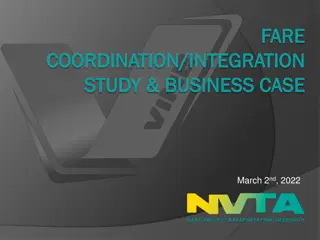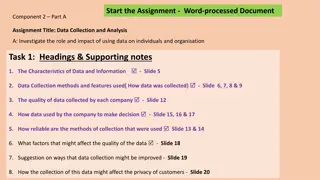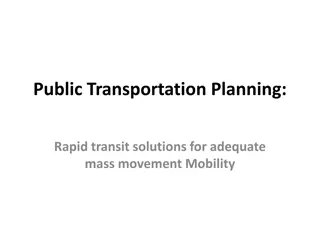Understanding Transit Survey Methods for Data Collection
Explore the various types of surveys used in transit systems, including longitudinal, cross-sectional, and single-point surveys. Learn about different survey modes such as on-board/intercept, telephone, mail, web-based, and smartphones. Understand the advantages and limitations of each survey method, from easy administration to response rates and target populations, with insights into on-board and telephone surveys.
Download Presentation

Please find below an Image/Link to download the presentation.
The content on the website is provided AS IS for your information and personal use only. It may not be sold, licensed, or shared on other websites without obtaining consent from the author. Download presentation by click this link. If you encounter any issues during the download, it is possible that the publisher has removed the file from their server.
E N D
Presentation Transcript
Unit 2: Describing Transit Systems with Data Data Collection With Surveys Materials developed by K. Watkins, J. LaMondia and C. Brakewood
Outline Types of surveys Methods of sampling Survey content Survey instruments Data collection plan Materials developed by K. Watkins, J. LaMondia and C. Brakewood
Last time we discussed the type of information we collect. Now, let s discuss how we go about collected detailed survey data. TYPES OF SURVEYS Materials developed by K. Watkins, J. LaMondia and C. Brakewood
Types of Surveys Longitudinal survey Over time Cross-sectional survey Single point in time Materials developed by K. Watkins, J. LaMondia and C. Brakewood
Survey Modes 1. On-board/Intercept 2. Telephone 3. Mail 4. Web-based 5. Smartphones (emerging) Materials developed by K. Watkins, J. LaMondia and C. Brakewood
On-Board & Intercept Surveys Overview Pros & Cons + Easy to administer + Inexpensive + Relatively high response rates (33%-67%*) Conducted on-board vehicles, in stations or at stops Target (study) population is current riders Very common: 96% of transit agencies conducted on-board surveys between 2002-2004* - Constraint of trip time on length of survey instrument (mail-back option) - Non-riders excluded Materials developed by K. Watkins, J. LaMondia and C. Brakewood
On-Board Survey Example Materials developed by K. Watkins, J. LaMondia and C. Brakewood
Telephone Survey Overview Pros & Cons + Riders and non-riders + Medium to long survey instruments + Good response rates Sampling frame is the household Often use Random Digit Dialing (RDD) Most common in cities with high use of transit 71% of transit agencies conducted telephone surveys between 2002-2004* - Interviewer training (Computer Aided Telephone Interviewing, or CATI, can help) - Respondent needs a (local) telephone Materials developed by K. Watkins, J. LaMondia and C. Brakewood
Mail Survey Overview Pros & Cons + Riders and non-riders + Longer survey instruments + Easy to administer + Eliminates interviewer bias Sampling frame is the household Somewhat common 38% of transit agencies conducted mail surveys* - Response rates can be very low; typically below 20%* - Usually not used for origin- destination surveys Materials developed by K. Watkins, J. LaMondia and C. Brakewood
Web Survey Overview Pros & Cons + Very inexpensive + Very easy to administer + Longer survey instruments + Eliminates interviewer bias + Data already coded Sampling frame is riders (usually) Increasingly common 44% of transit agencies conducted mail surveys between 2002-2004* - Respondent needs to have internet - Difficult to achieve random sample Materials developed by K. Watkins, J. LaMondia and C. Brakewood
Smartphone Survey Overview Native smartphone applications can be used for travel surveys Geocoded travel information supplemented with survey questions Still in research & development Some state DOTs; limited (if any) use in transit Pros & Cons + Geocoded travel information + Longer survey instruments + Relatively easy to administer + Data already coded - Respondent needs to have a smartphone - Difficult to achieve random sample - Privacy concerns Materials developed by K. Watkins, J. LaMondia and C. Brakewood
METHODS OF SAMPLING Materials developed by K. Watkins, J. LaMondia and C. Brakewood
Methods of Sampling Simple Random Sampling Systematic Sampling every nthunit selected Stratified Sampling divide the population into homogenous groups (e.g. areas of the city) Cluster Sampling natural groups, sample within groups Probability Proportionate to Size selection probability proportional to size Materials developed by K. Watkins, J. LaMondia and C. Brakewood
Sample Size Determination Depends on the population size (e.g. number of riders) and the level of precision desired Increase sample size increase costs Example for Simple Random Sampling Materials developed by K. Watkins, J. LaMondia and C. Brakewood
What is commonly included in transit surveys? SURVEY CONTENT Materials developed by K. Watkins, J. LaMondia and C. Brakewood
Research Goals & Content Origin & Destination Surveys This trip : Origin, destination, purpose, access mode, egress mode, etc. General Travel Behavior Frequency of travel, how long using transit, alternative modes Demographics Gender, age, race, driver s license, HH income, HH size, employment status Satisfaction Attributes of service: timely service, speed of service, cleanliness, comfort, safety, crowing, information Other Fare payment, new technologies, communications, etc. Materials developed by K. Watkins, J. LaMondia and C. Brakewood
Translating Research into Survey Questions Materials developed by K. Watkins, J. LaMondia and C. Brakewood
How to write a good survey SURVEY INSTRUMENT Materials developed by K. Watkins, J. LaMondia and C. Brakewood
Types of Questions Closed-Ended Dichotomous (2 answers, e.g. Yes/No) Nominal (Categorical) Ordinal (a.k.a. Likert, Ranking) Filter/Contingency (Qualified) Partially-Closed Last answer is Other______ Open-Ended Materials developed by K. Watkins, J. LaMondia and C. Brakewood
Dos and Donts Questions should NOT be: Double-barreled Double negative Technical jargon Long-winded Redundant Obtrusive or embarrassing Questions should be: Concise (multiple choice) Understandable Useful Exhaustive Materials developed by K. Watkins, J. LaMondia and C. Brakewood
Now, its time for you to practice IN-CLASS EXERCISE Materials developed by K. Watkins, J. LaMondia and C. Brakewood
Putting it all together in order to create a DATA COLLECTION PLAN Materials developed by K. Watkins, J. LaMondia and C. Brakewood
Creating a Data Collection Plan 1. Determine research goals 2. Select survey mode & sampling methodology 3. Determine necessary sample size 4. Create detailed sampling plan 5. Draft questionnaire 6. Pre-test the questionnaire 7. Conduct staff training 8. Distribute survey & revise sampling plan 9. Code/process data & error check Materials developed by K. Watkins, J. LaMondia and C. Brakewood
Other Considerations Language English & Spanish Special groups Those who cannot read/write Longitudinal comparisons Consistency of questions with prior transit surveys Materials developed by K. Watkins, J. LaMondia and C. Brakewood
What does a (good) transit survey look like? CHICAGO TRANSIT AUTHORITY Materials developed by K. Watkins, J. LaMondia and C. Brakewood
2003 Chicago Transit Authority Customer Satisfaction Survey Objective: Comprehensive review of customer satisfaction conducted every 2 to 3 years Content Included: General travel behavior (modes, trip purpose) Satisfaction with service delivery attributes Loyalty towards CTA Technology use (internet access, CTA website) Fare payment Demographics Materials developed by K. Watkins, J. LaMondia and C. Brakewood
CTA: Mode & Sampling Mode: Household Telephone survey Random Digit Dialing Computer Assist Stratified Sampling Area of residence (N, S, NW, SW, W, Suburbs) Mode (rail or bus) Sample Size Minimum of 200 respondents per strata Total of 2,577 responses Materials developed by K. Watkins, J. LaMondia and C. Brakewood
CTA: Questionnaire Question types Mostly closed-ended questions (scales typically 5 points) A few partially closed (other) & open ended questions Interview length Average of 21.4 minutes to complete Pre-tested to assure length Response rate 64,986 telephone numbers attempted Materials developed by K. Watkins, J. LaMondia and C. Brakewood
CTA: Results Satisfaction with bus service: Has improved terms of reliability, information services, and comfort, among other things. Has decreased in regards to access to service, personal safety, and intramodal transferring (within CTA). Satisfaction with rail service: Has improved or stay constant in terms of operator attributes (personnel), information sources, reliability and fare payment, among other things. Has decreased in regards to access to service, intramodal travel, personal safety, and appearance. Materials developed by K. Watkins, J. LaMondia and C. Brakewood
CTA: Results Materials developed by K. Watkins, J. LaMondia and C. Brakewood
Conclusion Surveys are a good way for agencies to know who their riders are and what they want. There are several survey types with varying costs, penetration and bias. They should be chosen to match their target. Surveys should be easy to understand and should encourage participants to complete them. Materials developed by K. Watkins, J. LaMondia and C. Brakewood
Reference Materials in this lecture were taken from: Schaller. On-board and Intercept Transit Survey Techniques . Transit Cooperative Research Program Synthesis 63, National Research Council, Washington, DC (2005). CTA, Customer Satisfaction Survey, 2003. Materials developed by K. Watkins, J. LaMondia and C. Brakewood























